History is replete with examples of software flaws costing tech companies billions of dollars and even leading to severe casualties at times. To avoid or minimize the risk of such occurrences, the practice of software testing was introduced. This phase in the software development cycle ensures that the released product functions as expected and is safe to use. To that end, several software testing methodologies are deployed, as per the nature of the software and its intended purpose.
Software testing methodologies refer to a mix of testing strategies and approaches adopted by tech teams to ensure an application or software product looks and behaves as expected. These encompass anything and everything from performance testing to security testing, front-end to back-end testing, as well as system and unit testing.
These encompass everything from front to back-end testing, including unit and system testing. More often than not, quality assurance professionals work with a mix of testing methodologies. This is done to ensure that your software development process is on the right track and the resulting product will operate successfully in diverse environments and across various platforms.
When supported by the right quality assurance services, the software testing methodologies can guarantee that every component of software behaves and performs exactly the way business analysts or design teams intended it to.
To grasp the role of testing methodologies, let’s look at what these are and how they can be optimally incorporated into your software development process.
What are Software Testing Methodologies?
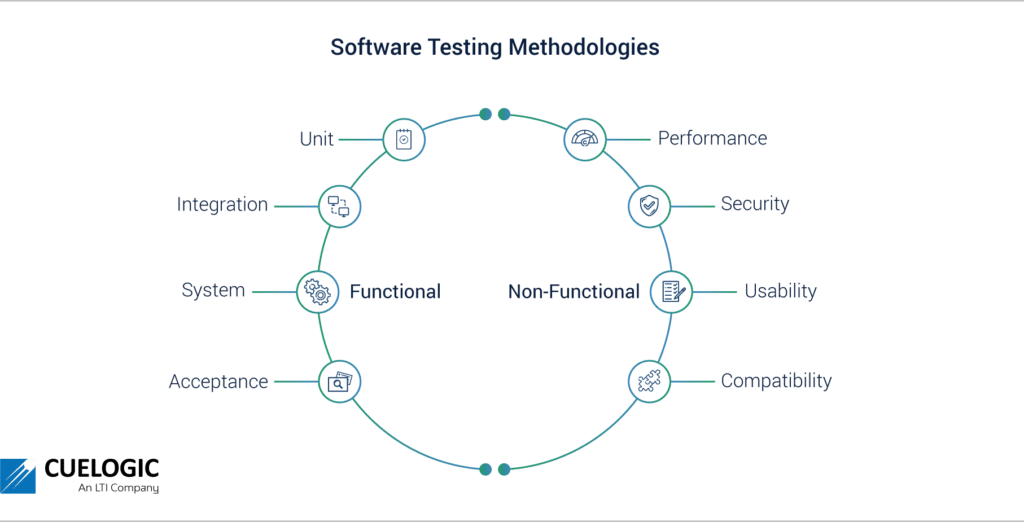
Testing methodologies comprise of a mix of approaches and strategies used to test whether a product is fit to serve the purpose it is designed for. It typically involves testing the product in accordance with pre-defined specifications to ensure that it doesn’t behave in an unpredictable or undesirable manner when used outside the design and development environment. And in the worst-case scenario, it fails safely.
Software testing methodologies work on the same principles and cover everything from testing individual software modules, integrating the software into a system or networks, as well as security and performance parameters.
Importance of Software Testing Methodologies
The importance of having robust software testing methodologies is felt more acutely than ever before. As software applications become more intricate and closely intertwined, and the number of platforms, devices, and applications grows exponentially, testing software products and systems to make sure that they are equipped to meet their specific requirements has become non-negotiable. The cost and consequences of releasing software products without being doubly sure that they can operate successfully in all anticipated environments are far too high to be ignored. It is for these reasons that software testing has become an integral part of the development process.
Top Software Testing Methodologies
Software testing methodologies entail a combination of principles, ideas, strategies, concepts, and methods that test a software application or product on the parameters of its fitness to serve its intended purpose. Today, there are dozens of different, highly effective testing methodologies – each with its start points, logic, methods, and duration of execution – available to quality assurance teams. Let’s take a look at some of the more popular ones that are most commonly used for software testing:
Agile Methodology
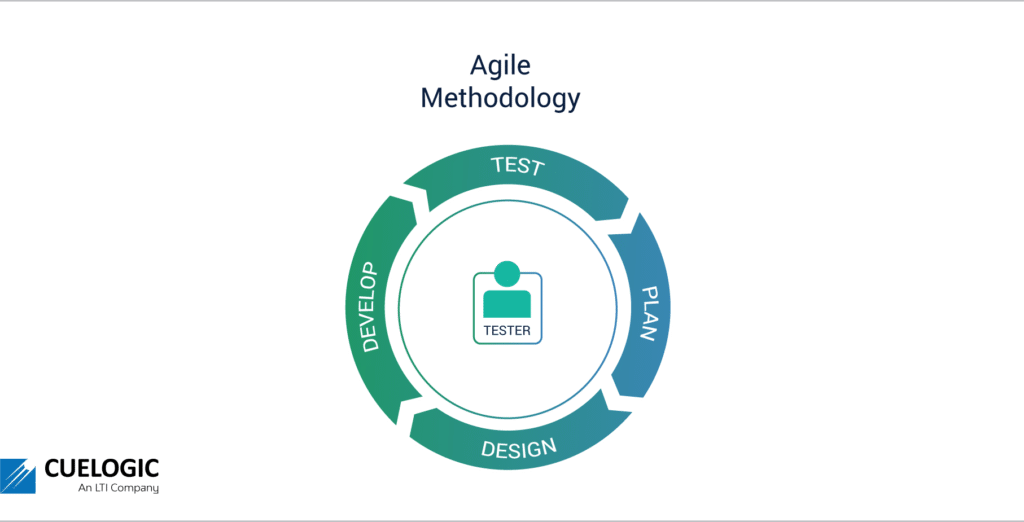
Agile methodology is an incremental and iterative approach that divides the software development process into smaller sprints, iterations, or parts. As a result, the software is also released in small increments, each building upon the previously released functionalities. Agile methodology allows testers to carry out performance testing parallel to the development process, facilitating a quick turnaround time for fixing issues as they arise. The goal here is to deliver the best quality software functionalities in the shortest time possible. Owing to its ability to deliver on this goal, agile software testing has emerged as the most popular and commonly used software testing methodology.
Agile Methodology Pros
By adopting an agile approach to software development, you can:
· Support the need to make requirement changes with an adaptive testing approach
· Fix errors early on in the software development process for maximum cost-effectiveness
· Deliver high-quality products
· Make software applications and products essentially bug-free
· Facilitate communication and coordination between different teams working on a software development project
· Ensure optimal development choices for long-term and big projects
· Manage easily all involved processes and workflows
· Obtain cost savings with a minimal resource requirement
Agile Methodology Cons
However, the agile methodology is not perfect. This methodology:
· Depends heavily on precise pre-defined customer requirements
· Has unpredictable time and effort requirements for large projects
· Possesses questionable suitability for complex projects
· Enhances maintainability risks
· Lacks documentation efficiency
Waterfall Methodology
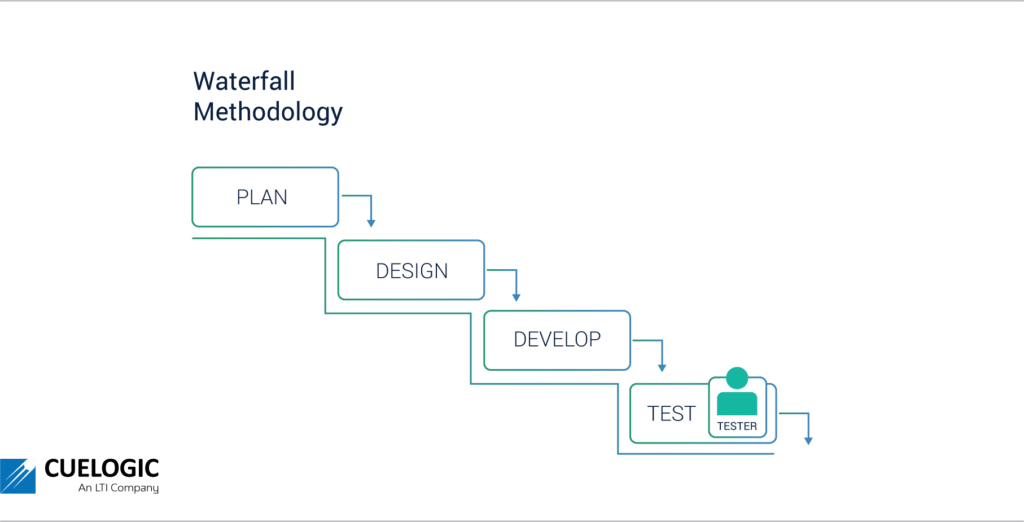
Developed by Winston Royce in 1970, the Waterfall Methodology is one of the oldest software testing methodologies that has stood the test of time and is still around. Also known as the linear-sequential life cycle model, this approach to software testing entails testing in multiple stages sequentially, making the whole process flow progressively from the top-down, much like a waterfall. This also means that when you use waterfall methodology for performance or security testing, you can move onto the next stage of the development or testing process only once the previous one has been successfully executed. And once you’ve made that transition, there is no turning back.
Waterfall Methodology Pros
Although a legacy methodology, the Waterfall Methodology has the following advantages.
· Ease of use
· Straightforward testing and analysis
· Time-efficient and cost-effective
· Ideal for small projects with clearly defined requirements
· Tolerant of managerial control and departmentalization
Waterfall Methodology Cons
However, the Waterfall Methodology is:
· Uncertain and risky
· Sub-optimal when it comes to visibility for current progress
· Not suitable for projects with dynamic requirements
· Challenging to make changes once the product is in the testing phase
· Unfit for complex or large projects
Verification and Validation Methodology (V-Model)
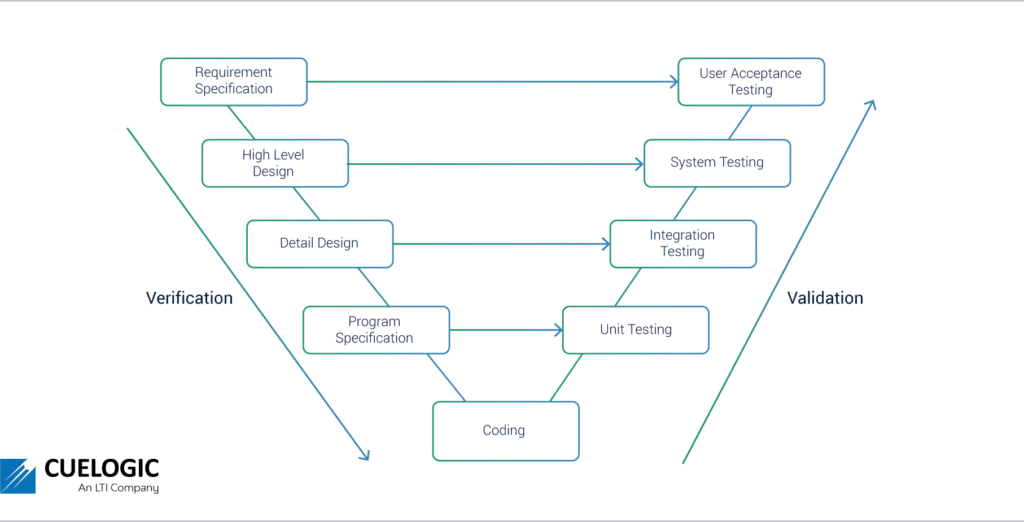
The verification and validation methodology, commonly referred to as the V-Model, is essentially an extension of the Waterfall Methodology. Here too, the execution of software testing takes place sequentially, but instead of following a top-down approach, it’s done in a V-shaped manner. Every phase of the software development process has a corresponding testing phase. The testing process begins once all the requirements are ready. Using the V-Model, you can perform static testing and review and verification to weed out the possibility of flaws in different development stages as they emerge. This software testing methodology is divided into three phases: verification, coding, and validation.
V-Model Pros
· Easy to use
· Avoids overlapping through sequential execution of testing phases
· Best suited for small projects with clearly defined requirements
· More cost-effective than the Waterfall approach
V–Model Cons
· Cannot support dynamic or changing requirements
· Lacks clear solutions to eliminate defects
· Testing happens at the end of the development phase
· Not compatible with complex or large projects
RAD Model (Rapid Application Development Testing Model)
The Rapid Application Development (RAD) software testing methodology also allows different software components to be developed parallel to one another. It is thus considered another version of the incremental approach. RAD lets you focus primarily on building prototypes that look and behave exactly like the final products and cater to the defined user requirements. The prototype is created by putting together the different software components developed simultaneously. This prototype is then used to assimilate customer feedback.
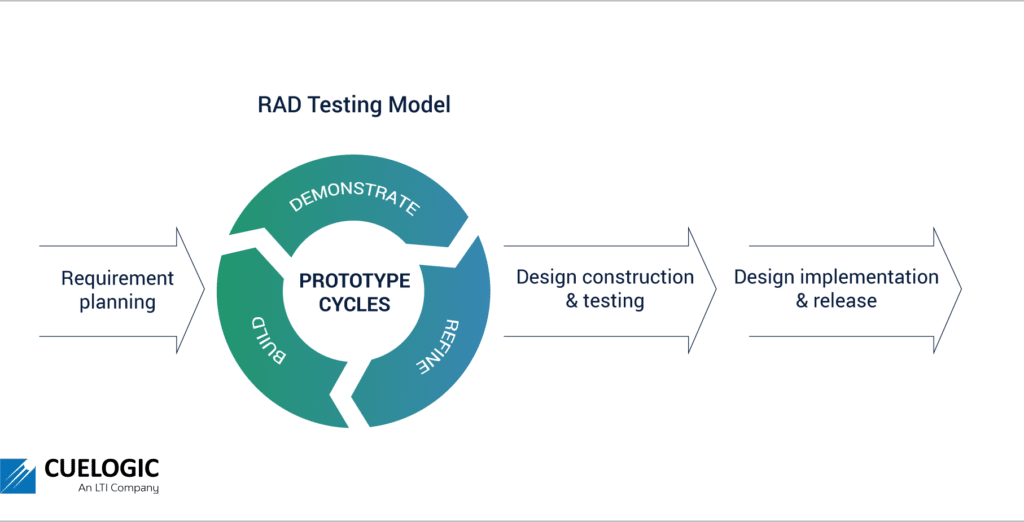
RAD Model Pros
The RAD model is used by developers and testers because it:
· Shortens the software development and testing cycle
· Leverages the time-box approach to software testing, which reduces risks and cost
· Enhances customer involvement
RAD Model Cons
However, like all models, the RAD model has some disadvantages. This model:
· Requires highly skilled resources
· Functions on a system that can be modularized
· Is incompatible with legacy systems
Spiral Model
The spiral model for software testing blends the iterative approach with the sequential testing format of the Waterfall Methodology. This form of software testing is executed in four phases: planning, risk assessment, engineering, and evaluation. Once a cycle is completed, the next one is initiated. This allows a product to pass through each of the four phases of testing in iterations – or spirals, as they are called in this software testing methodology. The baseline spiral serves as the foundation for every subsequent spiral that is built during the testing process. The Spiral approach is characterized by its unique emphasis on risk assessment during the testing phase.
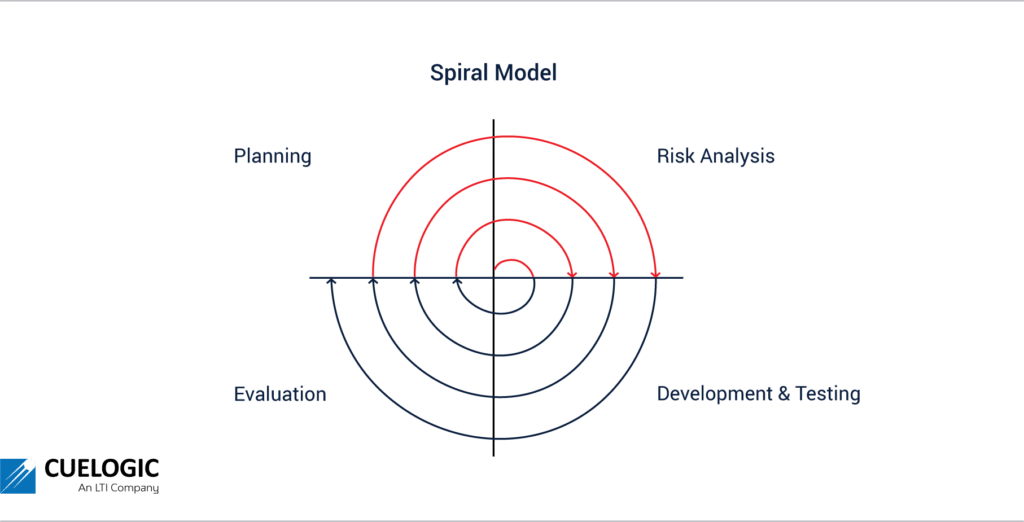
Spiral Model Pros
The Spiral Model is adopted by engineers because it:
· Lowers the risk factor substantially by focusing on risk assessment
· Works effectively with mission-critical or large projects
· Improves product quality by providing instant and continuous feedback at the third stage of the testing cycle
· Has a capability to accommodate requirement changes
· Possesses strong documentation control
· Supports rapid development
Spiral Model Cons
The Spiral Model can be sub-par because it:
· Is expensive
· Doesn’t align well with small projects
· Needs highly skilled experts
· Entails elaborate intermediate stages
Which Software Methodology to Choose
The methodologies available for the software development process and corresponding testing are diverse and expanding. However, not all software testing methodologies are created equal. They are each designed to serve a specific purpose and come with their share of advantages and disadvantages.
There is no one-size-fits-all answer to which software methodology to choose. To arrive at the right decision, you have to factor in key variables such as the nature and size of the project, client requirements, the timeline of the project, resources, and the skill set available at your disposal.
From the perspective of software testing alone, too, you have to assess which one would fit almost seamlessly with the software development project you have at hand. Some methodologies entail testing input early on in the software development lifecycle, while others introduce it right at the end or wait until a complete working model is ready to be tested.
Therefore, the choice of software methodology depends on how dynamic your requirements are and how often and early you’d like to test a product in the works to assess its efficiency and suitability.
When all of these variables are factored into a choice, zeroing in on the best possible approach becomes more accessible and less confusing.
How to Set up Software Testing Methodologies
Once you’ve identified which software testing methodologies you’d like to adopt for a particular project, comes the task of setting it up. Setting up the software testing methodology should not be done from the perspective of testing code alone. For optimal results, you have to also be mindful of the bigger picture and not lose sight of the primary goals of software testing.
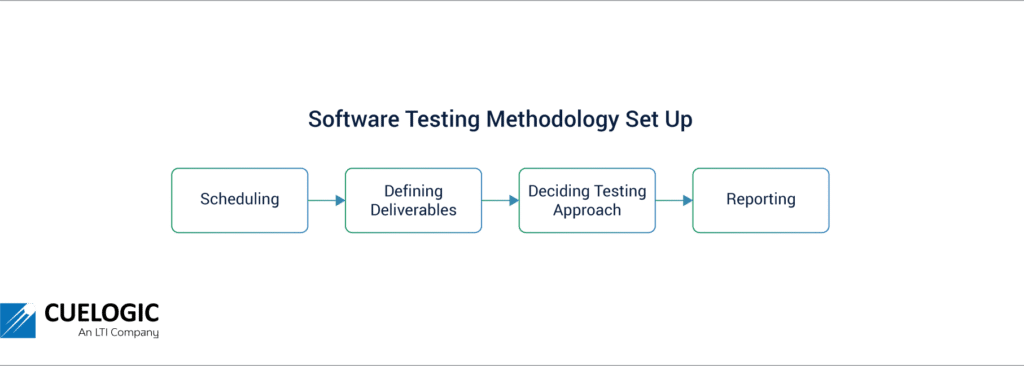
Here are some things to keep in mind when setting up software testing methodologies:
· Scheduling: The success of the software testing approach depends heavily on setting realistic schedules. The schedule should be planned such that it meets the requirements of every member on the team.
· Defining Deliverables: Clearly defined deliverables are also a key component to the success of your software testing efforts. The deliverables should be laid out so that every team member understands them and is on the same page about what needs to be done. This requires weeding out any ambiguity in the content.
· Deciding the Testing Approach: Once you’ve completed scheduling and planning pre-defined deliverables, the onus of formulating the best-suited software testing strategy must fall on the testing team. Developer meetings and detailed documentation can be constructive in the process.
· Reporting: Transparent reporting is the backbone of effective software testing, irrespective of the nature, size, or criticality of the project. However, transparency can also be the hardest to achieve. That’s why it must be prioritized.
Conclusion
The key objective of software testing is delivering optimum quality products at the fastest pace possible. Each of the software testing methodologies at your disposal today employs a different approach for performance testing, security testing, and quality assurance of various products and applications. Each of these testing approaches also has its shares of strengths and weaknesses.
Being mindful of the different variables at play is the best way to make a tough choice simple.
